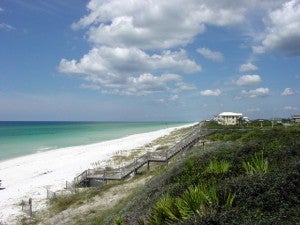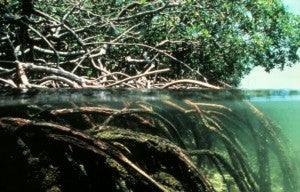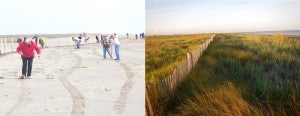New report quantifies storm reduction benefits of natural infrastructure and nature-based measures
By Shannon Cunniff, Deputy Director for Water, Environmental Defense Fund
Coastal zones are the most densely populated areas in the world. In the U.S., they generate more than 42 percent of the nation’s total economic output. These coastal communities, cities and infrastructure are becoming increasingly vulnerable to the effects of climate change. Rising seas and increased storms, as well as ongoing coastal development, have stripped these natural environments of their innate resilience to storms and flooding, leaving coastlines and the people who live there especially exposed.
Protecting coastal areas requires a multipronged approach. Traditional hardened infrastructure, such as levees and floodwalls, should be combined with natural infrastructure, such as dunes and barrier islands, to optimize storm protection. By attenuating wave energy, natural infrastructure measures can enhance the performance of and complement traditional gray infrastructure. And in certain situations, natural coastal infrastructure measures can reverse coastal erosion, help rebuild shorelines and even keep pace with rising sea levels.
Natural coastal infrastructure measures also provide significant co-benefits to communities. In addition to reducing the effects of storm waves and surge, these wetlands and other plant-based means also improve water quality, enhance recreational and commercial fisheries, add to the coastal esthetic and attract tourists. Their installation or restoration can also buy time for communities as they develop long-term strategic plans to cope with sea level rise.
In Louisiana, coastal planners understand the importance of nature-based designs, such as sediment diversions and barrier beach nourishment, when developing coastal restoration and protection plans – the state’s Coastal Master Plan is a combination of restoration, protection and resiliency projects.
But with their myriad of benefits, why aren’t natural infrastructure measures being implemented to a greater degree in other parts of the nation?
In part, the reason is the lack of accepted engineering design guidance – a document that explains the engineering principles, issues, methods, and performance metrics for evaluating, siting and designing features. Lacking such, engineers cannot formally sign off on the designs and risk benefits that will be realized.
How can we quantify the storm risk reduction benefits of nature-based measures, so as to help decision-makers and planners choose the best methods for their needs and find financing to implement these projects? Can we accelerate development of engineering guidance?
Natural Infrastructure Workshop and Report
Seeking to answer these questions, Environmental Defense Fund (EDF) convened a workshop of 19 coastal engineers, scientists, program managers, and financiers to discuss establishing storm risk reduction performance measures of various natural coastal infrastructure solutions.
After completion, EDF produced the report, “Performance of Natural Infrastructure and Nature-Based Measures as Coastal Risk Reduction Features,” which reviews the state of knowledge on the risk reduction performance of natural and nature-based infrastructure, compiled from existing literature as well as workshop participant input. The report includes findings on a host of nature-based measures, including beach nourishment, vegetated dunes, barrier island restoration, edging and sills (living shorelines), oyster reefs, coral reefs, mangroves, maritime forests and coastal wetlands (non-mangroves).
While the report is a bit technical, the authors hope that city planners, coastal engineers and other decision-makers find it useful when determining which storm protection measures to implement in their communities.
For each of the measures, the report summarizes its storm risk reduction attributes (e.g., wave attenuation and storm surge protection); lists its strengths, known weaknesses and uncertainties about utility for risk reduction; and identifies suitable conditions for implementation. The report also indicates where engineering design guidelines already exist (e.g., for beach nourishment and dune building) and whether they can be created by modifying existing guidelines (e.g., oyster and coral reefs function like submerged breakwaters).
For the layperson, Table 1 is a one stop shop for information on how each storm risk reduction measure stacks up next to other methods. The table is a summary of the strategies – natural, nature-based, as well as structural – and how each compares regarding risk reduction performance, costs, climate change mitigation, and adaptability to seal level rise and changing community needs.
To guide further research supporting adoption of natural infrastructure into coastal resilience plans, the report provides the most catalytic and pressing research needs and lists other survey needs gathered from the literature or raised during the workgroup discussion.
Workshop participants – and subsequent consultation with other engineering experts – confirm that there is sufficient confidence in the ability of natural coastal infrastructure measures to reduce impacts of storms and sea level rise to coastal communities, such that these approaches should be routinely considered as viable options by decision-makers.
With what we know now, implementation of these approaches can be facilitated by developing detailed engineering guidelines that provide functional and structural design guidance as well as address other design issues. As projects are built and monitored, we can further expand knowledge of the circumstances where these measures work best; learn more about how traditional structural, nonstructural, natural infrastructure and nature-based measures can optimally work together; understand how coastal processes are effected; and track the measures’ life expectancies in our increasingly dynamic coastal environments.
You can show your support for coastal restoration by taking the pledge to urge leaders to be a powerful voice for coastal restoration. Take the pledge at RestoretheCoast.org!


